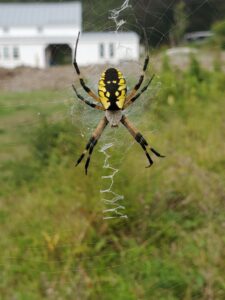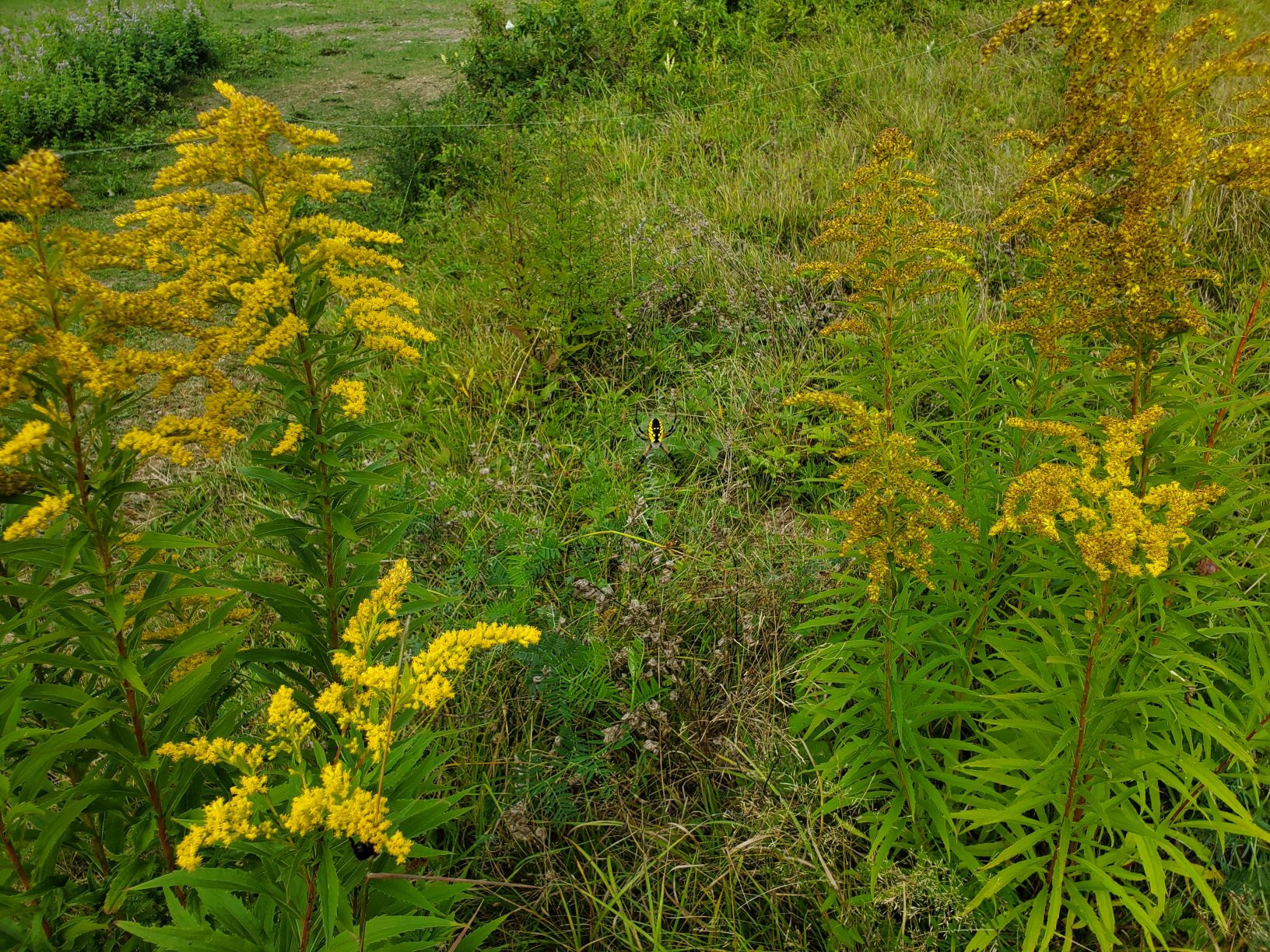September 4: Black and Yellow Garden Spider

If you find yourself walking through a field of flowers in late summer, you might stop in your tracks at the sight of one of Maines largest spiders. Or the spider might stop you when you accidently walk through its web that it has stretched across a pathway. These enormous spiders have abdomens the size of a quarter with contrasting yellow and black coloration, which continues along with a shade of orange to form bands on their long legs. Sitting front and center on its zig-zag patterned web, it doesn’t take much effort to notice Argiope aurantia, or what is commonly known as the black and yellow garden spider. You would be hard pressed to miss it.
The webs are usually found about knee-high off of the ground in sunny and quiet areas in a field or garden, where they are somewhat concealed and protected from the wind. Black and yellow garden spiders can also be found along the eaves of buildings or any tall vegetation where they can stretch and secure a web. The female spider spends almost her whole life in the web, with the smaller and less colorful males traveling to the females to mate. The web is circular, up to 2 feet in diameter, with a dense zig-zag of silk, known as a stabilimentum, in the center. It is believed that the stabilimentum helps hide the spider, but it may also warn birds of the presence of the concealed web, or attract insect prey looking for a surface to land on.
In a nightly ritual, the spider consumes the interior circular part of the web, and then rebuilds it each morning with fresh new silk. It is believed tha t the spider does this to recover the chemicals used in web building and to consume minuscule insects and other organic matter containing nutrition. During the daytime, the spider occupies the center of the web, usually facing straight down, waiting for larger prey to become ensnared. When prey is caught in the web, the spider may bounce the web back and forth to further trap it. When the prey is secure, the spider injects it with deadly venom and wraps it in a cocoon of silk for later consumption. Their black and yellow garden spider eats a variety of invertebrates including aphids, flies, grasshoppers, mosquitoes, wasps and bees.
t the spider does this to recover the chemicals used in web building and to consume minuscule insects and other organic matter containing nutrition. During the daytime, the spider occupies the center of the web, usually facing straight down, waiting for larger prey to become ensnared. When prey is caught in the web, the spider may bounce the web back and forth to further trap it. When the prey is secure, the spider injects it with deadly venom and wraps it in a cocoon of silk for later consumption. Their black and yellow garden spider eats a variety of invertebrates including aphids, flies, grasshoppers, mosquitoes, wasps and bees.
When a male black and yellow garden spider finds a female, he will build a small web near or actually in the female’s web. He will then court her by plucking the strands of her web. The male usually approaches the female with a silken safety drop line ready, just in case she attacks him and he needs to escape. If things go well, the spiders will mate, after which the male will die and is sometimes eaten by the female. She lays her eggs at night on a sheet of silky material, which she covers with another layer of silk, then a final protective layer of brown colored silk. She works the sheet into a ball with her legs and suspends the egg sac onto her web.
Each female spider produces one to four egg sacs, each with around a 1000 eggs inside. She guards the eggs against predators until the weather cools and she becomes frail, with adult spiders usually dying with the first hard frost. The spiderlings hatch in the fall, but stay in the protective egg sack for the winter and emerge in the spring. At first they are so tiny that they look like dust gathered inside the silk mesh. When summer rolls around, some of the spiderlings remain nearby, but others exude a strand of silk that gets caught by the breeze, carrying them to a more distant area.
If you see the strikingly beautiful black and yellow garden spider in your yard, there is no reason to relocate or kill it. They are beneficial and bring natural balance to their surroundings. Although people may be concerned about being bitten, they are not dangerous. They may bite when harassed, but the venom is harmless to non-allergic humans and feels no worse than a bee sting. In fact, their eyesight is quite poor, so just admire them from a few inches away and they won’t even know you are there.




